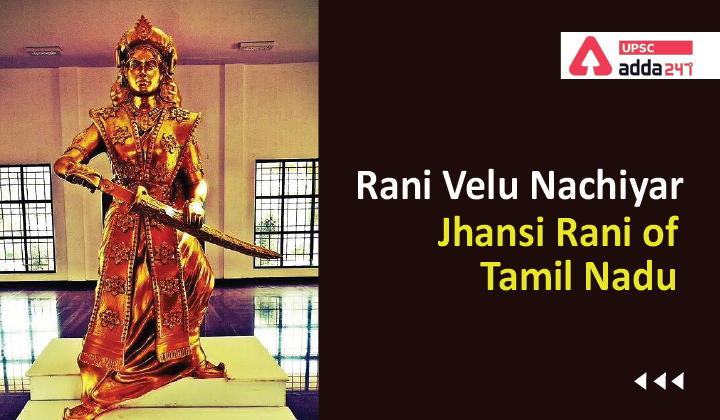Table of Contents
Rani Velu Nachiyar- Relevance for UPSC Exam
- GS Paper 1: Indian History- Indian culture will cover the salient aspects of Art Forms, Literature and Architecture from ancient to modern times.
Rani Velu Nachiyar- Context
- Recently, the Prime Minister has paid tributes to Rani Velu Nachiyar on her birth anniversary.
- He said that her indomitable courage shall keep motivating the coming generations. Her strong commitment to fighting colonialism was remarkable. She personifies the spirit of our Nari Shakti.
Rani Velu Nachiyar– Key Points
- About: Rani Velu Nachiyar was the first queen of Tamil origin to fight against the British in India. Rani Velu Nachiyar was an inspiring-women in the south.
- Velu Nachiyar is still held in high regard in Tamil Nadu with the moniker ‘Veeramangai’ or brave woman bestowed upon her by the people.
- Rebellion against British Rule: Rani Velu Nachiyar formed an army and fought and won against the British in 1780, with the military assistance of Hyder Ali.
- Rani Velu Nachiyar was drawn into battle after her husband was killed by the British.
- Protection of Hyder Ali: Rani Velu Nachiyar lived under the protection of Hyder Ali of Mysore near Dindigul.
- Idea of Human Bomb: Rani Velu Nachiyar was said to have come up with the idea of a human bomb.
- Her Rule: Rani Velu Nachiyar also formed a women’s army and was one of the few rulers who regained her kingdom and ruled for 10 more years.
- She ruled the kingdom for over a decade before bequeathing the royal commitments to the Maruthu brothers at her death in 1796.
Raja Ram Mohan Roy- Indian Social Reformer
Additional Information- Kuyili
- About: Kuyili had risen up to the ranks of commander-in-chief in queen Velu Nachiyar’s military entourage.
- Fight against Britishers: Kuyili devised a strategy that would involve women infiltrating through the watchdog eyes of the British and entering the Sivaganga fort.
- Upon her command, Kuyili’s companions poured ghee and oil that were meant for lighting the lamps, upon her.
- Following this, a valiant Kuyili walked into the armoury chambers with her head held high and set herself on fire.
- Kuyili sacrificed her life for the motherland that would go on to help Velu defeat the troops and reclaim her fort and sovereignty.
- Recognition: Kuyili’s name has somehow faded away from the public memory, except for a memorial in the Sivaganga district by the state government that was erected only recently.
Azadi Ka Amrit Mahotsav- Climate Change Awareness Campaign and National Photography Competition
Azadi Ka Amrit Mahotsav- Climate Change Awareness Campaign and National Photography Competition





 TSPSC Group 1 Question Paper 2024, Downl...
TSPSC Group 1 Question Paper 2024, Downl...
 TSPSC Group 1 Answer key 2024 Out, Downl...
TSPSC Group 1 Answer key 2024 Out, Downl...
 UPSC Prelims 2024 Question Paper, Downlo...
UPSC Prelims 2024 Question Paper, Downlo...




